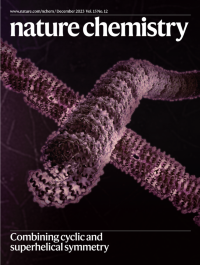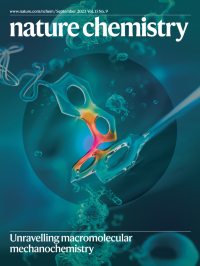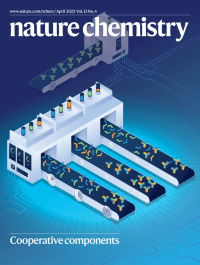Volume 15
-
No. 12 December 2023
Combining cyclic and superhelical symmetryCyclic and superhelical symmetry are prevalent in nature. Less common is the occurrence of these symmetries along coincident axes — such as that in coiled coils — which can be exploited in biological systems and leveraged in protein engineering. Superhelical symmetry can be found in helical repeat proteins, and de novo helical repeat proteins are rigid and amenable to stacking in a head-to-tail fashion, which is an important factor in building up coincident symmetries. Now, using cyclic helical repeat proteins, Baker and colleagues generate protein nanostructures — as depicted on the cover — with coincident cyclic and superhelical symmetry axes.
See Bethel et al.
-
No. 11 November 2023
Observing interferenceConical intersections are important in many photoactive systems, often playing a defining role in the reactivity and dynamics of important processes such as light harvesting, vision and photocatalysis. Kassal, Tan and colleagues have now engineered a controllable conical intersection in a trapped-ion quantum simulator, enabling the observation of geometric-phase interference in the dynamics of a wavepacket travelling around the conical intersection. The cover shows an artist’s impression of a conical intersection emerging from a single, laser-driven trapped ion. The blue wavepacket encircling the conical intersection splits into two lobes, which undergo geometric-phase interference.
See Valahu et al.
-
No. 10 October 2023
Fibril formation promoted at the interfaceThe molecular process by which neurodegenerative disease-associated amyloid fibrils mature from protein condensates has so far been unknown. Now Arosio and colleagues uncover that fibril formation is promoted at the interface of condensates of the low-complexity domain of hRNPA1, a protein associated with amyotrophic lateral sclerosis. This liquid-to-solid transition is inhibited by coating the interface of the droplets with surfactant molecules. For proteins that follow such a molecular mechanism for fibril formation, the interface could prove to be a therapeutic target against aberrant protein aggregation. The cover depicts the low-complexity domain of hnRNPA1, condensates, and the start of fibril formation at a condensate’s interface.
See Linsenmeier et al.
-
No. 9 September 2023
Unravelling macromolecular mechanochemistryPolymer chains can stretch and break when a macromolecular solution is subjected to rapid flow, but the molecular events leading to fragmentation are poorly understood. Now, Roman Boulatov and Robert T. O’Neill compare the rate of two mechanochemical reactions in the same polystyrene chain — the Z→E isomerization of a stiff stilbene mechanophore and C–C bond scission — as a function of chain tension. These studies provided information about the molecular events that occur before mechanophore activation and chain scission, enabling them to elucidate that a segment of the chain unfolds, and this stretched segment drifts along the polymer backbone. The cover shows an artistic representation of the stiff stilbene mechanophore in the polymer chain.
See O’Neill & Boulatov
-
No. 8 August 2023
Copper-catalysed carbene chemistryWhile the use of metal catalysts to control the reactivity of carbenes has long offered a powerful approach to organic synthesis, copper difluorocarbene chemistry has so far been elusive. Now, Xiao-Song Xue, Xingang Zhang and co-workers have synthesized and isolated copper(I) difluorocarbene complexes, which have enabled the development of a copper-catalysed difluorocarbene transfer reaction. The cover depicts an artistic representation of the copper(I) complex reacting with free difluorocarbene compounds.
See Zeng et al.
-
No. 7 July 2023
Complex colloidal clathrate crystalsClathrates, which consist of host molecules arranged in a hierarchy of polyhedral cages around guest species that they encapsulate, have attracted much attention for their host–guest chemistry. Now, using simulations, Sharon Glotzer and co-workers have shown that hard, otherwise non-interacting particles with truncated triangular bipyramid shapes self-assemble into open colloidal crystals isostructural to clathrates using only entropy. The resulting structures (depicted on the cover) consist of freely rotating guests within a rigid host network.
See Lee et al.
-
No. 6 June 2023
Arene addition1,3-Dipolar cycloadditions are well known transformations in organic synthesis, however, the reactivity of benzene rings in these processes is underexplored. Now, a team led by Valery V. Fokin has shown that diazoalkenes — generated in situ from lithium acetylides and N-sulfonyl azides — can undergo intramolecular 1,3-dipolar cycloaddition with aromatic rings. The process provides a route for the synthesis of medicinally relevant heterocycles. The cover shows an artistic representation of an aromatic ring reacting with a diazoalkene.
See Aggarwal et al.
-
No. 5 May 2023
Dynamic chirality controlStereogenic sp 3-hybridized carbon centres are the principal building blocks of chiral organic molecules. Usually, these centres are configurationally fixed. Now, a team led by Paul R. McGonigal has taken advantage of low-energy pericyclic rearrangements to create rigid cage molecules with fluxional sp 3 stereochemistry, influencing chiral information transfer. The sp 3-carbon stereochemistry of the cages is inverted through strain-assisted Cope rearrangements. The cover shows the fluxional carbon cage structure.
See Bismillah et al.
-
No. 4 April 2023
Cooperative componentsMany biological nanomachines are assembled from multiple components, but the functional advantages of nanosystems composed of multiple self-assembling molecules compared with those formed from just one component are not well understood. Now, Dominic Lauzon and Alexis Vallée-Bélisle use a DNA-based model system to provide insight into the functionalities that emerge when a nanostructure assembles from multiple components. The cover depicts the programmable assembly of trimeric nanosystems in an anti-cooperative and cooperative manner, and with control over the time-dependence of formation.
See Lauzon et al.
-
No. 3 March 2023
Effects of enzyme entanglementEnzymes with identical sequences of amino acids can display different levels of activity when they are encoded with different messenger RNA (mRNA) sequences; however, the reason for this has not been clear. Now, a team led by Edward P. O’Brien has shown that synonymous mutations in mRNA can alter the partitioning of proteins into long-lived soluble misfolded states, and that these different states can possess different levels of activity. The cover depicts an enzyme adopting a misfolded structure during the folding process.
See Jiang et al.
-
No. 2 February 2023
Carbon nanohoops through and throughInterlocked nanocarbons have been attracting attention on account of both their intriguing structures and potential utility, but their synthesis is challenging. Now, a team led by Ramesh Jasti has used an active-template approach to efficiently prepare such threaded compounds. A metal ion held in the central cavity of a macrocyclic precursor catalyses cross-coupling reactions to form a series of mechanically interlocked intermediates. These are then converted into fully π-conjugated species, such as the catenanes and rotaxane depicted on the cover.
See May et al.
-
No. 1 January 2023
Tailored properties through controlled polymerizationStereochemistry is a crucial yet hard to control parameter that influences the physical properties of polymers. Now, Quentin Michaudel and co-workers disclose a stereocontrolled acyclic diene metathesis (ADMET) polymerization that leverages the high stereoselectivity of a dithiolate Ru catalyst and uses specifically designed diene monomers to afford polymers with predictable compositions of cis and trans alkenes. This strategy enables the thermal properties and crystallinity of various polymers to be modulated through modification of their cis:trans alkene content. The cover shows an artistic representation of diene monomers and oligomers undergoing stereocontrolled ADMET through reaction with the Ru catalyst to form cis alkenes.
See Hsu et al.












